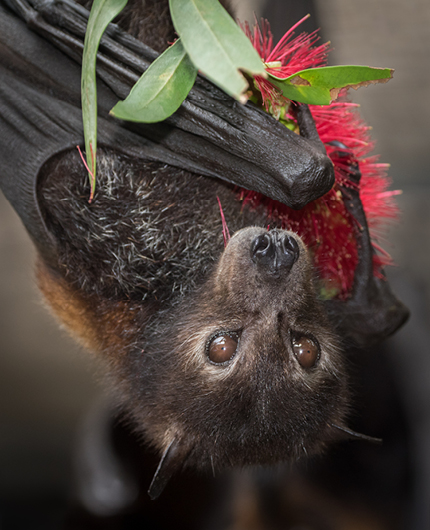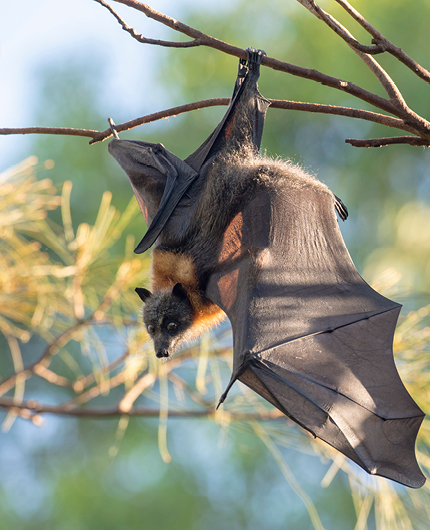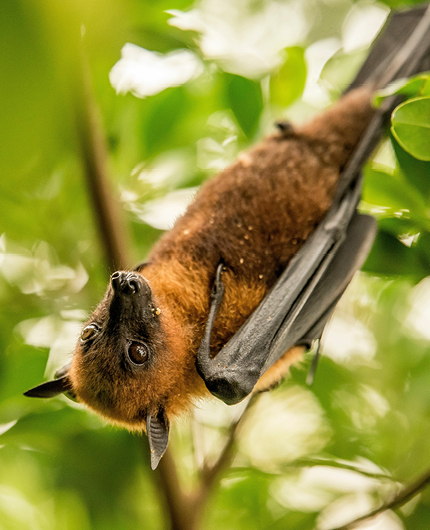Flying Foxes
The Fraser Coast is home to three species of flying fox which play a vital role in the conservation of native forests in the area. Flying foxes are protected under the Nature Conservation Act 1992 and are a unique and highly intelligent species of native fauna, whose presence adds significance to our already internationally recognised region. The flying foxes found on the Fraser Coast are:

Black flying fox (Pteropus alecto)
The Black flying fox mainly roosts in wet and dry eucalyptus forests/trees, mangroves, melaleuca swamps and casuarinas. Black flying foxes form permanent camps, often with Grey-headed flying foxes (Pteropus poliocephalus), and feed on nectar, flowers and fruits of native trees and on cultivated fruit (bananas, paw paws, mangoes, lychees) when native food is scarce.
Distinguishing characteristics:
- Facial features – head covered with black fur, often with brownish tinge around the large dark brown eyes.
- Fur on head, neck and body – Short, jet black fur, often tipped with white on body. Dark chocolate brown patch often around back of neck and shoulders (mantle). Legs black and hairless.
- Wings – Black, opaque, stretching length of body to ankles and inner thighs.
- Dimensions – Weight 600-1000g. Head-body length between 230-280mm.

Grey-headed flying fox (Pteropus poliocephalus)
The Grey-headed flying fox occupies similar habitat to Black flying foxes, but over a smaller range that extends south into Victoria.
Populations that once extended north to Rockhampton are now contracting southward of Maryborough in response to diminishing forest resources.
The species was listed as nationally “vulnerable to extinction” under the Environmental Protection and Biodiversity Conservation Act (1999) in December 2001.
Distinguishing characteristics:
- Facial features – Large, dark brown eyes. Grey fur.
- Fur on head, neck and body – Collar of golden fur fully encircles the head. Fur long, almost fluffy. Grey to frosted silver hair extends down the legs to the toes.
- Wings – Black, opaque, stretching length of body to ankles and inner thighs.
- Dimensions – Weight 600-1000g. Head-body length 230-289mm.

Little Red flying fox (Pteropus scapulatus)
Little Red flying foxes are highly nomadic and as part of their nomadic behaviours they visit the Fraser Coast region as they follow the flowering of the eucalypts along Australia’s eastern seaboard. They play an important role in the pollination of our native forests and leave the Fraser Coast once flowering has finished.
Distinguishing characteristics:
- Facial features – Large, red-brown eyes. Greyish coloured fur.
- Fur on head, neck and body – Reddish-brown to light brown with light creamy brown patches where wing membrane and shoulder meet. Legs are red brown and hairless.
- Wings – Reddish brown, semi transparent in flight. Outline narrower than the Black and Grey-headed flying foxes.
- Dimensions – Weight – 300-600g (making them the smallest of the three species).
-
With well-developed sensory systems, flying foxes rely on eyesight, sound and smell to interact with their environment. Unlike smaller, micro bat cousins, they do not echolate or use ultrasound.
Flying foxes are social mammals which spend the day hanging in the canopy of trees at their camp. They fly out at dusk to feed and can travel up to 50km from their campsite in search of nectar, blossoms and fruit.
Female flying foxes become sexually mature at 2-3 years and give birth to one young per year. Young are cared for during a period of three to four months after which they become independent. Flying fox hazards include predators such as goannas, snakes, powerful owls, eagles, foxes, dogs and cats as well as man-made items such as powerlines and barbed-wire fences. A flying fox may reach 8-10 years of age.
-
Flying foxes have a vital role in the regeneration of native forests. Due to their nocturnal feeding habits and extensive feeding ranges, flying foxes are able to pollinate tree species which produce most of their nectar at night and are thus less easily serviced by day-feeding birds and bees. The dispersal of seeds by flying foxes may happen in one of three ways:
-
fruit may be taken from a tree, consumed elsewhere and large seeds spat out some distance from their origin.
- fruit may be taken away and dropped during transit.
- fruit may be taken and eaten on-site but small seeds excreted elsewhere.
The seeds of many species of rainforest trees will only germinate if moved some distance from the parent tree. Due to their ability to carry large fruit and move it over considerable distances, flying foxes are responsible for maintaining genetic diversity amongst remnant patches of forests.
Pollen is collected on the fur of flying foxes while feeding on the nectar of flowers. It attaches mainly to the head and neck region and is thus distributed between different feeding sites. This may lead to cross-pollination between flowers of the same tree or between flowers of different trees of the same species in separate forest patches. Native eucalypts depend on cross-pollination for maximum fruit-set and seed viability.
-
-
Flying foxes use sound as a means of communication. Their hearing is similar to humans, making their calls clearly audible to our ears. Vocalisations between individuals are necessary for social communication, eg during the defence of territories.
Periods of noise occur mainly at dawn and dusk when the bats arrive at or prepare to leave the camp. Calls during the day occur mainly during the mating season in March/April or as a response to disturbances. These may include roaming dogs, birds of prey, planes, machinery noise (chain-saws, lawn-mowers, loud bangs) in or near the camp or people walking among the roosting bats. Flying fox noise can be minimised by preventing disturbances at the camp sites.
-
Scent plays an important role in the life of a flying fox, as it’s a vital part of their communication. Glands located on their shoulders allows a male flying fox to secrete a strong odour for marking his territory and attracting females during the mating season. Whilst female flying foxes are able to locate their young in amongst thousands of other flying foxes in the colony by following the scent emitted by their offspring.
Defecation is primarily done at feeding sites, not roosting sites, so any odour associated with a flying fox camp is not coming from droppings, it is actually the flying foxes themselves. As with humans, hot and humid weather can intensify this smell. Flying foxes can defecate in flight, splattering objects beneath their flight path with excrement or guano.
-
In recent decades, the increasing modification of our natural environment has had a detrimental impact on most species of flora and fauna, including flying foxes. Extensive clearing of native forests for agriculture and urbanisation has diminished the habitat of much of our native wildlife to small, isolated patches. The loss of this forest resource and its function as food-provider and roosting habitat has led to an increased confrontation between flying foxes and people.
Small forest remnants in urban areas are often overcrowded with bats, and seasons of poor fruiting and flowering in nature force hungry flying foxes to turn to cultivated fruit as an alternative.
Council’s Statement of Management Intent for flying fox roosts within Council managed land is to not disturb the colony, and to instead allow the flying foxes to disperse naturally. This decision is based on research, and the experience of other land management agencies throughout Australia, which shows that disturbing and relocating flying fox roosts is an expensive and uncertain operation. There are no guarantees they won’t return to the site they were dispersed from.
Statement of Management Intent for Flying Fox Roost Management
If you are interested in learning how to co-exist with flying foxes, and steps that can be taken to minimise their impact on you and your property, the below tips may be useful:
- Don’t purposely disturb flying foxes. Disturbed colonies will often be the noisiest and most highly stressed. Disturbance can also impact on the effectiveness of management actions. If animals are too exhausted from being disturbed all day, they are less likely to be able to relocate to another area.
- Park cars under shelter where possible.
- Bring washing in before sunset. This is when bats begin foraging.
- Install netting around fruit trees (or put bags around fruit). It is preferable to use white thick-knitted netting pulled tight rather than black netting, to reduce the risk of wildlife becoming entangled.
- Avoid the use of barbed wire fences near flowering plants so that flying foxes can’t become ensnared.
- If you see a sick, injured or orphaned flying-fox, contact your local wildlife care organisation or RSPCA Queensland. They will put you in contact with a licensed and vaccinated wildlife rescuer.
- Don’t attempt to pick up or touch a flying fox and ensure that children are aware that they need to report any sick, injured or orphaned flying foxes to a responsible adult.
Please note that the management of flying fox roosts on privately owned land is the responsibility of the landowner. If you are concerned about a roost on your land you can apply to the Department of Environment and Science for a Roost Management Permit.
-
Several viruses capable of causing diseases in animals and humans have been linked to flying foxes in recent years. Of these, Hendra virus (equine Morbillivirus) and Australian bat Lyssavirus are the most notable.
Research by the Queensland Department of Primary Industries and Fisheries (DPI&F) and others has shown that some species of bats act as a natural reservoir of infection for these viruses, and so members of the public are strongly advised against handling any bat. Only those few trained individuals who are protected by vaccination and suitable equipment should care for them.
Some types of bacteria (such as Salmonella) which can impact human health are found in bat faeces from time to time, and members of the public occasionally express concern about potential contamination of swimming pools or rainwater tanks.
-
Rainwater Tanks - If the droppings land on your roof, and you collect rainwater for drinking purposes, contaminants could wash into your rainwater tank. In these instances, it is advisable to have a device that allows the first flush of rainwater to be diverted from your tank. It is always good hygiene practice to keep your rainwater tank covered, install an internal water filter, and at regular intervals chlorinate the tank and drain and clean both the tank and the roof area used for rainwater collection.
- Swimming pools - Normal pool maintenance practices (cleaning, filtration and chlorination) should remove any contamination associated with flying fox droppings. If any concerns still exist, contact your local pool contractor.
-
-
Flying foxes often visit properties where native eucalypts, bottlebrushes, lily-pillies, figs and melaleucas are flowering. Blossoms are their primary source of food. They will also feed on palm seeds and exotic fruits when native food is less abundant.
Horse owners should follow these steps to protect their horses:
- Place feed and water containers under cover if possible.
- Do not place feed and water containers under trees, particularly if flying foxes are attracted to those trees.
- Do not use feed that might be attractive to flying foxes if they are known to be in the area. Fruit and vegetables (eg. apples, carrots) or anything sweet (eg. molasses) may attract flying foxes.
- If possible, remove horses from paddocks where flowering or fruiting trees have resulted in a temporary surge in flying fox numbers. Return the horses after the trees have stopped flowering or fruiting.
- If removal of horses from paddocks is not possible, restrict their access to the areas where the flying foxes are active and for the period of time they are present (eg. under trees while flowers and fruit are present).
- People are urged to be extremely vigilant if their horse displays rapid onset of clinical signs, including raised temperature, respiratory distress and/or neurological signs. In this case, horse owners should contact their local veterinarian for further advice.
-
Flying foxes may be found in need of help for several reasons, such as being caught in fruit tree netting, on barbed-wire fencing, fishing line entanglement, power line hit / electrocution, vehicle strike, lying on the ground or hanging alone in a tree, and young ones orphaned or separated from their mother.
If you find a flying fox or any species of bat in need of assistance, do not touch it, but call a wildlife carer ASAP. In case of a bite or scratch injury from any type of bat, wash injury site thoroughly with soap and water and contact your local GP.
If you find a bat that you think is dead, do not touch it with your bare hands.
The best way to dispose of the body is by picking it up wearing pierce-proof gloves, using a plastic bag and towel or a spade, and disposing of the body in a bin, wrapping it in a sturdy plastic bag first. Do not make direct contact with the bat.
During the months of September to January, female flying foxes may be carrying their babies with them, snuggled in under their wing. It is important check thoroughly that there is not a live baby on the dead adult before disposal. If you find a baby on board, or need a dead bat checked, contact a wildlife rescuer on 1300 ANIMAL (1300 264 625).
To report sick, injured, orphaned or deceased flying foxes in the Fraser Coast region call RSPCA on 1300 ANIMAL (1300 264 625).
